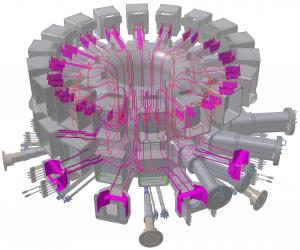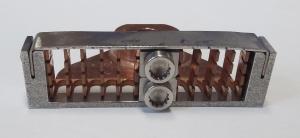In-vessel electrical systems
What it takes to wire up a fusion reactor
9 Apr 2020
-
Pat Brans
While the challenges of keeping cables operational in harsh environments such as jet engines and nuclear fission reactors have been understood for a long time, protecting cables inside fusion reactors is a different story. Fusion presents a new set of challenges—challenges that can only be overcome with a new round of innovation.
In-vessel cables transmit signals and power between the vacuum vessel and the buildings. They are present in all areas—attached to vacuum vessel sectors, behind blanket modules, under the divertor, and in upper and lower ports.
"If the diagnostics are the eyes of the project, the electrical systems are the nerves," says Matt Clough, vacuum electrical engineer for the In-Vessel Diagnostics Section. "The electrical systems provide the power and signal paths for the diagnostic systems to take the measurements and report back."
The in-vessel electrical services form part of the chain to connect the diagnostic systems situated at the heart of the machine to the control cubicles and electronics situated in the buildings. This means running cables inside the vacuum vessel to feedthroughs on the upper and lower points—electrical connectors that serve as high-integrity safety boundaries, helping to keep nuclear material inside the vessel and impurities outside the vessel.
The feedthroughs are not the only things that ensure tight boundaries. "The cables also have a special termination at both ends to keep the ultra-high vacuum level," says Miguel Pérez-Lasala, who—as diagnostics project manager with the European Domestic Agency, Fusion for Energy—is overseeing the procurement of the first 1,200 cables. "While this technology already existed, we needed to test it to make sure it could be safely used for ITER—and then, based on those tests, we had to make some changes to suit our needs."
From decades of research to manufacturing readiness
Research on cables began during the ITER Engineering Design Activities phase back in the 1990s, starting with what was already known from fission reactors. Through laboratories in Europe, Japan, the United States and Russia, members of the small ITER community ran a series of tests to see if the same design concepts would hold up under fusion.
But to their dismay, the cables generated spurious outputs. "Heating of the cables generated tiny voltages, like a set of random, slowly changing batteries set in series with some of the most delicate signals that control the machine," says George Vayakis. A member of the initial research team, Vayakis now leads the ITER In-Vessel Diagnostics Section.
Twenty years later, the mechanisms behind these phenomena have still not been perfectly modelled. But through a series of irradiation experiments, including those most recently conducted by Fusion for Energy at the Belgium-based SCK·CEN, researchers have learned enough about the basic behaviour to finalize the design. Further tests, by Fusion for Energy and the Hungarian-based TSD consortium, served to validate the concepts and qualify the final versions of the cables. In December 2019, Fusion for Energy signed a procurement contract with the French company Thermocoax (see full report here).
A unique set of solutions to a unique set of challenges
Whether the cables provide power or signaling paths, keeping those cables functioning in a vacuum vessel presents a number of challenges. The first is keeping the cables cool. If they get too hot, or if there are temperature changes along the length of the cable, they become unreliable, delivering either garbled signals between the control room and diagnostics, or no signals at all.
"We try to keep the cables below 250 °C," says Julio Guirao, common port plug components engineer for the Diagnostic Engineering Section. "Any hotter than that, and the wires inside degrade and you lose performance."
Many thousands of individual cables will be needed inside the vessel, bundled into "looms" of up to 36 cables each. Because drilling is forbidden in nuclear pressure vessels like ITER's, the cables will be affixed to the vessel wall by welded clamps called "bosses" spaced approximately every 60 mm.
Cooling the cables is complicated due in part to sheer volume—about 3,800 signal lines from a variety of diagnostic and operational instrumentation clients and in every sector of the vessel, according to Clough. "We're very limited for space, so we have to bundle them together (up to 36 cables) to form over 100 cabling "looms"—and keep them cool at the same time. We don't have cooling pipes in the looms, but we can make use of the fact that the vessel itself is water-cooled. So the heat from every single cable in the bundle has to be transferred to the vessel wall—and that turns out to be very tricky."
Bespoke clamps were designed for this purpose, made from a special copper alloy (CuCrZr) offering good thermal conductivity and high strength. The clamps also needed to be flexible enough to accommodate variations in cable diameter. With strong support from Budapest-based C3D, the ITER Organization developed a large variety of concepts before choosing the final design. The prototype clamps were then extensively tested under a range of conditions replicating those inside the ITER machine on dedicated test rigs built and operated by GEMS in Hungary.
Over 12,000 clamps will be installed inside the vessel, positioned at intervals of around 60 mm along each cable. Finding a method to affix the clamps, while respecting the strict rules and regulations of a nuclear pressure vessel that preclude drilling, has also been a challenge.
"A company based in the United Kingdom, Intransic Engineering, devised 'bosses,'—small cylindrical attachments that you can put a bolt into, and which are welded to the vessel," says Clough. Julio Guirao and his colleagues were able to demonstrate, through highly detailed finite element models, that each cable remained within nuclear safety standards.
Millimetre precision and cables that last
The diagnostic cables installed in the ITER vessel—mineral insulated and copper-coated, within stainless steel jackets—will not be accessible for maintenance. They have to last for the lifetime of the project, withstanding twenty years of bombardment from neutrons, plasma radiation and heating beams.
The final prototype clamp, complete with battle scars from testing. Over 12,000 clamps will be installed inside the vessel, positioned at intervals of around 60 mm along each cable.
Cabling requirements for every diagnostic client had to be agreed years in advance, so that cables could be developed, manufactured and installed in time for First Plasma. The teams has also had to consider cross talk—the electrical noise induced between the conductors inside of the same cable. "We studied and tested a variety of cable geometries—that is, the disposition and separation of the copper cores within the cables—to understand which one had a better cross-talk performance," says Pérez-Lasala.
Because the cables have to be sealed and terminated to make them vacuum compatible, they cannot be cut on site. Instead, manufacturers will produce each cable to the exact length needed. High levels of precision will be required—a mistake of a few millimetres could result in lost measurements during a pulse.
"Because we have to order the cables to a specific length, the routing of every single cable has to be modeled in 3D," says Clough, acknowledging the thousands of hours of painstaking work performed by C3D. "Every cable, clamp and clip is drawn, because we have to know the cable length to millimetre precision. The fact that we can't shorten or lengthen cables on-site also means we have to model upfront ways to accommodate a vessel that is not yet fully assembled."
"Because we have to order the cables to a specific length, the routing of every single cable has to be modeled in 3D," says Clough, acknowledging the thousands of hours of painstaking work performed by C3D. "Every cable, clamp and clip is drawn, because we have to know the cable length to millimetre precision. The fact that we can't shorten or lengthen cables on-site also means we have to model upfront ways to accommodate a vessel that is not yet fully assembled."
Cable length is not the only attribute calling for great precision—the bolts must also be tightened to exactly the right level, and locked in place without the possibility of coming loose.
"We have many thousands of individual cables to deal with, including the ones being procured by Fusion for Energy under the current contract," says Clough. "And we have to make sure we have reliability all along the signal chain. We're facing a unique set of challenges that are different even from other fusion experiments. Other tokamaks either don't have as many cables as we have, or they have fewer restrictions on the materials they can choose, or how the cables can attach to their vessel."
"We have many thousands of individual cables to deal with, including the ones being procured by Fusion for Energy under the current contract," says Clough. "And we have to make sure we have reliability all along the signal chain. We're facing a unique set of challenges that are different even from other fusion experiments. Other tokamaks either don't have as many cables as we have, or they have fewer restrictions on the materials they can choose, or how the cables can attach to their vessel."
After the vacuum vessel sectors are lowered in the Tokamak pit, the bosses and cables are among the first things to be installed. "My hope is that nobody will talk about these cables and clamps after they are installed," jokes Clough, "because they will just be quietly and reliably doing their job."




